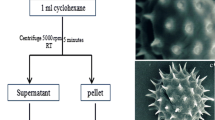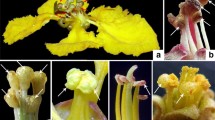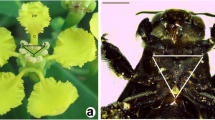Abstract
The active participation of ROS in the reproductive physiology of flowering plants is well-documented in model species, mainly plants with dry stigmas. Here we studied the release of ROS into stigma exudate—a fluid involved in pollen acceptance on a wet stigma. The study involved plants from different systematic groups: Paeonia suffruticosa, Nicotiana tabacum, Lilium hybr., Aristolochia manshuriensis and Berberis vulgaris; in most cases, exudate was collected from intact flowers on the whole plant to minimize the effect of experimental intervention on the sensitive redox balance system. The dynamics of total oxidizing capacity of stigma exudate was assessed by EPR spectroscopy and different stigma staining. The level of hydrogen peroxide and the activity of superoxide dismutase, which catalyzes H2O2 formation, was also evaluated. In all the plants studied, total ROS level increased with stigma maturation, however, H2O2 concentration decreased in studied representatives of eudicots, except for peony. In lily it increased, while in birthwort it remained low, which was apparently due to the absence of SOD activity. In all divergent plants studied, the enzyme was active on stigmas with two isoenzymes. During the fertile period, activity was higher than at an earlier stage. Based on the obtained data, we speculate on primitive and progressive patterns of ROS generation and transformation on stigma and its possible evolution.


Similar content being viewed by others
Data availability
The datasets generated during and/or analysed during the current study are available from the corresponding author on reasonable request.
References
Aslmoshtaghi E, Shahsavar AR (2016) Biochemical changes involved in self-incompatibility in two cultivars of olive (Olea europaea L.) during flower development. J Hortic Sci Biotechnol 91:189–195. https://doi.org/10.1080/14620316.2015.1133606
Baker CJ, Orlandi EW (1995) Active oxygen in plant pathogenesis. Annu Rev Phytopathol. https://doi.org/10.1146/annurev.py.33.090195.001503
Bartosz G (1997) Oxidative stress in plants. Acta Physiol Plant 19:47–64. https://doi.org/10.1007/s11738-997-0022-9
Bradford MM (1976) A rapid and sensitive method for the quantitation of microgram quantities of protein utilizing the principle of protein-dye binding. Anal Biochem 72:248–254
Breygina M, Klimenko E (2020) ROS and ions in cell signaling during sexual plant reproduction. Int J Mol Sci 21:9476. https://doi.org/10.3390/ijms21249476
Breygina MA, Abramochkin DV, Maksimov NM, Yermakov IP (2016) Hydrogen peroxide affects ion channels in lily pollen grain protoplasts. Plant Biol 18:761–767. https://doi.org/10.1111/plb.12470
Breygina M, Klimenko E, Shilov E et al (2021) Hydrogen peroxide in tobacco stigma exudate affects pollen proteome and membrane potential in pollen tubes. Plant Biol 23:592–602. https://doi.org/10.1111/plb.13255
Breygina M, Schekaleva O, Klimenko E, Luneva O (2022) The balance between different ROS on tobacco stigma during flowering and its role in pollen germination. Plants 11:993
Byng JW, Smets EF, Vugt R, Van et al (2018) The phylogeny of angiosperms poster: a visual summary of APG IV family relationships and floral diversity. Glob Flora 1:4–7
Chase MW, Christenhusz MJM, Fay MF et al (2016) An update of the angiosperm phylogeny group classification for the orders and families of flowering plants: APG IV. Bot J Linn Soc 181:1–20. https://doi.org/10.1111/BOJ.12385
Cui X, Liu S, Zhang L et al (2022) Endophytic extract Zhinengcong alleviates heat stress-induced reproductive defect in Solanum lycopersicum. Front Plant Sci. https://doi.org/10.3389/fpls.2022.977881
Dafni A (1992) Pollination ecology: a practical approach. Oxford University Press, Oxford
Dikalov SI, Kirilyuk IA, Voinov M, Grigor’Ev IA (2011) EPR detection of cellular and mitochondrial superoxide using cyclic hydroxylamines. Free Radic Res 45:417–430. https://doi.org/10.3109/10715762.2010.540242
Dikalov SI, Polienko YF, Kirilyuk I (2018) Electron paramagnetic resonance measurements of reactive oxygen species by cyclic hydroxylamine spin probes. Antioxid Redox Signal 28:1433–1443. https://doi.org/10.1089/ars.2017.7396
Djanaguiraman M, Perumal R, Jagadish SVK et al (2018) Sensitivity of sorghum pollen and pistil to high-temperature stress. Plant Cell Environ 41:1065–1082. https://doi.org/10.1111/pce.13089
Franklin-Tong N, Bosch M (2021) Plant biology: stigmatic ROS decide whether pollen is accepted or rejected. Curr Biol 31:R904–R906. https://doi.org/10.1016/j.cub.2021.05.034
Galen C, Plowright RC (1987) Testing the accuracy of using peroxidase activity to indicate stigma receptivity. Can J Bot 65:107–111. https://doi.org/10.1139/b87-015
Gao XQ, Liu CZ, Li DD et al (2016) The Arabidopsis KINβγ subunit of the SnRK1 complex regulates Pollen hydration on the stigma by mediating the level of reactive oxygen species in pollen. PLoS Genet 12:1–25. https://doi.org/10.1371/journal.pgen.1006228
Hiscock SJ, Bright J, McInnis SM et al (2007) Signaling on the stigma. Potential new roles for ROS and NO in plant cell signaling. Plant Signal Behav 2:23–24. https://doi.org/10.1111/j.1469-8137.2006.01875.x
Hu W, Huang Y, Bai H et al (2020) Influence of drought stress on pistil physiology and reproductive success of two Gossypium hirsutum cultivars differing in drought tolerance. Physiol Plant 168:909–920. https://doi.org/10.1111/ppl.13030
Inupakutika MA, Sengupta S, Devireddy AR et al (2016) The evolution of reactive oxygen species metabolism. J Exp Bot 67:5933–5943. https://doi.org/10.1093/jxb/erw382
Josephy PD (1985) Oxidative activation of benzidine and its derivatives by peroxidases. Environ Health Perspect VOL 64:171–178. https://doi.org/10.1289/ehp.8564171
Lai HY, Setyawati MI, Duarte CV et al (2022) Human hair proteins as natural reactive oxygen species scavengers for in vitro applications. J Biomed Mater Res. https://doi.org/10.1002/jbm.b.35203
Lan X, Yang J, Abhinandan K et al (2017) Flavonoids and ROS play opposing roles in mediating pollination in Ornamental Kale (Brassica oleracea var. acephala). Mol Plant 10:1361–1364. https://doi.org/10.1016/j.molp.2017.08.002
Leung DWM, Moon B, Wang Y (2006) Superoxide dismutase activity in the reproductive tissues of petunia flowers. Floriculture, ornamental and plant biotechnology. Global Science Books, Middlesex, pp 117–122
Li Z-G (2019) Chap. 5 - Measurement of signaling molecules calcium ion, reactive sulfur species, reactive carbonyl species, reactive nitrogen species, and reactive oxygen species in plants. In: Khan MIR, Reddy PS, Ferrante A, Khan NABT-PSM (eds) Plant Signaling Molecules Role and Regulation Under Stressful Environments. Woodhead Publishing, Cambridge, pp 83–103
Liu C, Shen L, Xiao Y et al (2021) Pollen PCP-B peptides unlock a stigma peptide–receptor kinase gating mechanism for pollination. Sci (80-) 372:171–175. https://doi.org/10.1126/science.abc6107
McInnis SM, Desikan R, Hancock JT, Hiscock SJ (2006) Production of reactive oxygen species and reactive nitrogen species by angiosperm stigmas and pollen: potential signalling crosstalk? New Phytol 172:221–228. https://doi.org/10.1111/j.1469-8137.2006.01875.x
Mishra V, Singh P, Kushwaha BK et al (2022) HPCA1 and HSL3: two plasma membrane proteins that probably cooperate to modulate H2O2 signalling under drought conditions. Plant Growth Regul 98:1–3. https://doi.org/10.1007/s10725-022-00829-6
Mittler R (2017) ROS are good. Trends Plant Sci 22:11–19
Podolyan A, Luneva O, Klimenko E, Breygina M (2021) Oxygen radicals and cytoplasm zoning in growing lily pollen tubes. Plant Reprod 34:103–115. https://doi.org/10.1007/s00497-021-00403-6
Ros Barceló A (1998) Hydrogen peroxide production is a general property of the lignifying xylem from vascular plants. Ann Bot 82:97–103. https://doi.org/10.1006/ANBO.1998.0655
Sankaranarayanan S, Ju Y, Kessler SA (2020) Reactive oxygen species as mediators of gametophyte development and double fertilization in flowering plants. Front Plant Sci 11:1199. https://doi.org/10.3389/fpls.2020.01199
Shivanna KR (2020) The Pistil: Structure in Relation to Its Function. Reproductive Ecology of Flowering Plants: Patterns and Processes. Springer, Singapore, pp 41–50
Smirnova AV, Matveyeva NP, Polesskaya OG, Yermakov IP (2009) Generation of reactive oxygen species during pollen grain germination. Russ J Dev Biol 40:345–353. https://doi.org/10.1134/S1062360409060034
Smirnova A, Matveyeva N, Yermakov I (2013) Reactive oxygen species are involved in regulation of pollen wall cytomechanics. Plant Biol 16:252–257. https://doi.org/10.1111/plb.12004
Souza EH, Carmello-Guerreiro SM, Souza FVD et al (2016) Stigma structure and receptivity in Bromeliaceae. Sci Hortic 203:118–125. https://doi.org/10.1016/j.scienta.2016.03.022
Steffen-Heins A, Steffens B (2015) EPR spectroscopy and its use in planta-a promising technique to disentangle the origin of specific ROS. Front Environ Sci 3:1–6. https://doi.org/10.3389/fenvs.2015.00015
Tezuka T, Tsuruhara A, Suzuki H, Takahashi SY (1997) A connection between the self-incompatibility mechanism and the stress response in lily. Plant Cell Physiol 38:107–112. https://doi.org/10.1093/oxfordjournals.pcp.a029139
Tsuruhara A, Suzuki H, Tezuka T (1999) Inhibition of the activity of NAD(P)H-dependent oxidase in pistils of Lilium longiflorum by cAMP. Plant Cell Physiol 40:1093–1098. https://doi.org/10.1093/oxfordjournals.pcp.a029492
Van Camp W, Inzé D, Van Montagu M (1997) The regulation and function of tobacco superoxide dismutases. Free Radic Biol Med 23:515–520. https://doi.org/10.1016/S0891-5849(97)00112-3
Xie D-L, Zheng X-L, Zhou C-Y et al (2022) Functions of redox signaling in pollen development and stress response. Antioxidants. https://doi.org/10.3390/antiox11020287
Zafra A, Rodríguez-García MI, Alché JDD (2010) Cellular localization of ROS and NO in olive reproductive tissues during flower development. BMC Plant Biol 10:1–14. https://doi.org/10.1186/1471-2229-10-36/FIGURES/9
Zafra A, Rejón JD, Hiscock SJ, Alché JDD (2016) Patterns of ROS accumulation in the stigmas of angiosperms and visions into their multi-functionality in plant reproduction. Front Plant Sci 7:1112–1119. https://doi.org/10.3389/fpls.2016.01112
Zhang MJ, Zhang XS, Gao X-Q (2020) ROS in the male–female interactions during pollination: function and regulation. Front Plant Sci 11:1–8. https://doi.org/10.3389/fpls.2020.00177
Zhang L, Huang J, Su S et al (2021) FERONIA receptor kinase-regulated reactive oxygen species mediate self-incompatibility in Brassica rapa. Curr Biol 31:3004-3016e4. https://doi.org/10.1016/j.cub.2021.04.060
Zhang X, Zhang L, Chen Y et al (2021b) Genome-wide identification of the SOD gene family and expression analysis under drought and salt stress in barley. Plant Growth Regul 94:49–60. https://doi.org/10.1007/s10725-021-00695-8
Zhou L-Z, Qu L-J, Dresselhaus T (2021) Stigmatic ROS: regulator of compatible pollen tube perception? Trends Plant Sci 26:993–995. https://doi.org/10.1016/j.tplants.2021.06.013
Acknowledgements
This research was funded by the Russian Science Foundation (project 21-74-10054). The authors express their deep gratitude to the students of Plant Physiology Department Alexandra Mayboroda, Alena Konoshenkova, Anastasia Kotik, Arina Makeeva, Nikita Aminov, Arseniy Potapenko and Alexandra Anisina who participated in experiments on living flowers as part of their summer practice, as well as Ekaterina Klimenko who supervised the students, to Moscow State Botanical Garden, especially curator of the peony collection Marianna Uspenskaya and director Vladimir Choob.
Funding
This research was funded by the Russian Science Foundation (Project 21-74-10054).
Author information
Authors and Affiliations
Contributions
Conceptualization, MB; zymography, OS; biophysics, OL and IAK; spectrophotometry, OS and KB; flower collection and pistil staining, KB and NL; writing, MB, NL and IAK. All authors have read and agreed to the published version of the manuscript.
Corresponding author
Ethics declarations
Competing interests
The authors have no relevant financial or non-financial interests to disclose.
Additional information
Communicated by Carlos Garcia-Mata.
Publisher’s Note
Springer Nature remains neutral with regard to jurisdictional claims in published maps and institutional affiliations.
Rights and permissions
Springer Nature or its licensor (e.g. a society or other partner) holds exclusive rights to this article under a publishing agreement with the author(s) or other rightsholder(s); author self-archiving of the accepted manuscript version of this article is solely governed by the terms of such publishing agreement and applicable law.
About this article
Cite this article
Breygina, M., Luneva, O., Schekaleva, O. et al. Pattern of ROS generation and interconversion on wet stigmas in basal and divergent angiosperms. Plant Growth Regul 101, 463–472 (2023). https://doi.org/10.1007/s10725-023-01033-w
Received:
Accepted:
Published:
Issue Date:
DOI: https://doi.org/10.1007/s10725-023-01033-w




